BORDER BUDA EXHIBITION
speed equals distance over time
Upon arrival in Buda – be it a singular visit or a routine part of one’s week – what immediately stands out is the presence of various transport axes in the area. Train lines and waterways, viaducts and tunnels, paths and highways, bike arteries and air traffic, each characterised by their distinctive range of speed. The network of persistent motion is set against the backdrop of a landscape that retains a relative stillness, shaped by the remnants of industrial development. Vacant buildings and rampant weeds occupy the area, a blind spot to many, as the sole audience for its dissonant polyphony.
In physics, speed is defined as the rate at which an object covers distance over a specific period of time. These three parameters – speed, distance and time – as elements that define experience in a given space, are the artistic points of departure for the presentation and creation of newly commissioned artworks in the public spaces of Buda. The formula also mirrors the methodological approach of the artists. What occurs when the speed parameter is altered, and how does this adjustment impact the ratio between distance and time? How does the variation in time, when isolated and rearranged within the equation, influence the outcome? Border Buda provides both space and time as essential factors for the development of artistic projects in the public sphere, with the distance overcome to reach the Buda area becoming an integral aspect of each project. The artistic processes harness the potential of speed, decelerating the urban rush and stimulating new encounters.
time equals distance over speed
The group exhibition that rounds up the first phase of the three-year project Border Buda consists of temporary and permanent installations by thirteen local and international artistic practices. These artworks have been developed in a site-sensitive manner, informed by and reflecting upon the historical, socio-cultural and ecological characteristics of the area. The seven temporary artworks, inaugurated simultaneously on April 26 but spanning over different temporalities of presence and permanence, were created by Amel Omar, Elias Cafmeyer, Ignace Wouters, Marine Kaiser, Pieter Chanterie, Nel Maertens and Zinaïda Tchelidze. This group of artists was composed through an open call to engage in a durational research residency trajectory, gathering every other week over seven months to explore the area of Buda together and meet with the local experts. The six permanent artworks, created by Evita Vasiļjeva, Haseeb Ahmed, Ilke Gers, Jean Katambayi Mukendi, Katja Mater, and Nico Neefs & Colas Fiszman unfold on different timelines. While the inauguration of Ilke Gers’ Landmarks in October 2023 marked the public launch of the project, the works of Evita Vasiļjeva, Haseeb Ahmed, Katja Mater, Nico Neefs & Colas Fiszman are inaugurated along with their temporary counterparts in April 2024, followed by the commission of Jean Katambayi Mukendi, that will be realised on the occasion of the 70th anniversary of Buda Bridge next year.
An important trajectory within Border Buda is focused on looking back in time. Het Be(h)lang van Buda, the socio-cultural heritage section of the project, collects knowledge about the history of the Buda area, working closely with the heritage enthusiasts of the local history circles from Vilvoorde, Machelen, Neder-Over-Heembeek and Haren. Besides functioning as the breeding ground for artistic and curatorial research in the process of creating the exhibition in public space, the stories collected through Het Be(h)lang van Buda will be shared through conversations and guided tours on April 27 and 28.
distance equals speed times time
Border Buda is an initiative that brings together three municipalities – Vilvoorde, Machelen and Brussels – whose borders run across Buda. Moreover, the area is traversed by the administrative and linguistic divide between Flanders and Brussels. Despite being integral to Buda’s identity, the borders that exist on maps dissolve on site, leaving subtle indications that hint at the geographic designation of a particular location, such as the hue of road markings or the visual style of street signs. The periphery, encapsulating numerous complexities in the challenge of living together, living with difference, often seems further and more rigid than it actually is. Border Buda aims to bridge this relative distance, drawing attention to Buda among the neighbouring residents and the broader (inter)national community through a series of artistic initiatives.
The project adopts the notion of change, rather than permanence, as the framework for conceptualising reality, thereby perceiving the area of Buda as continuously subject to transition. Within this motion, we seek to notice the forms of being that emerge as a blueprint for life in urban environments, and as guides towards the future.
Anna Laganovska and Koi Persyn
Amel Omar
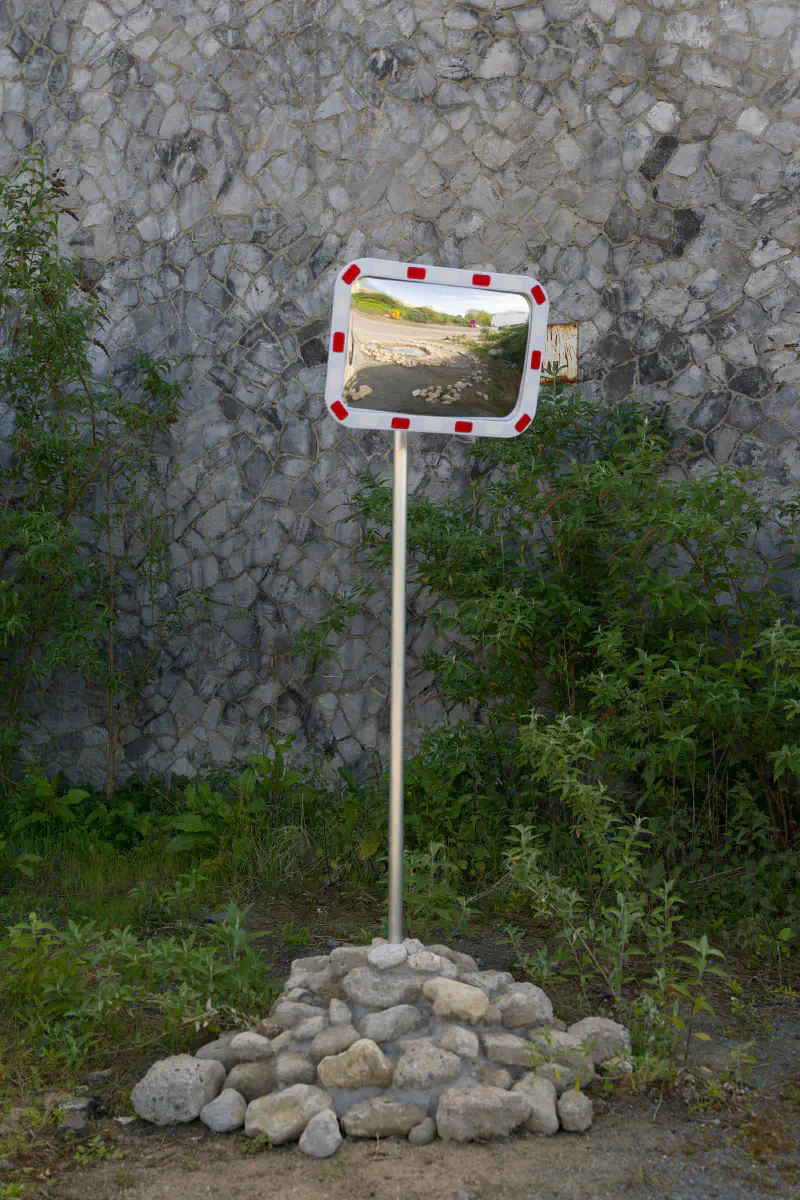
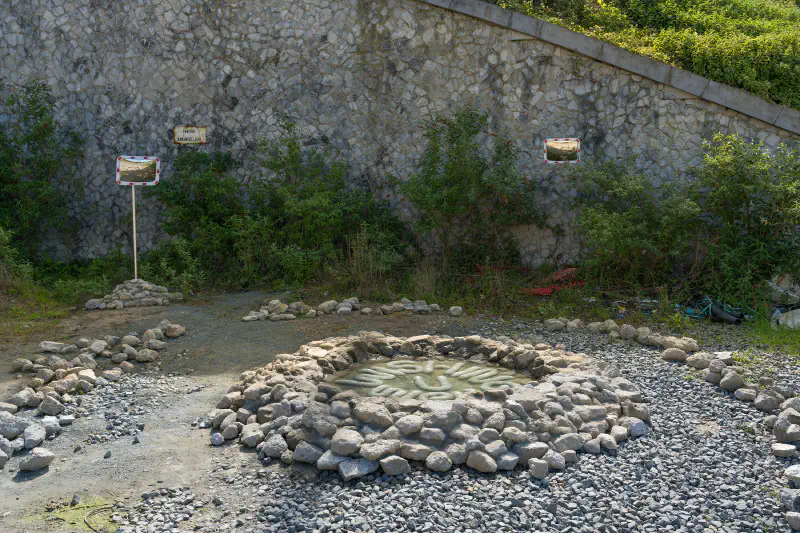
photo by Lola Pertsowksy
Amel Omar - Wishing u well, 2024
Emmanuellaan - Nieuwbrugstraat, Machelen
Water sources, essential for supporting all forms of life, have traditionally held a sacred significance. The practice of making wishes by offering tokens, such as coins or cherished items, into wells is a shared tradition across European cultures, with roots dating back to medieval times. The mirrored surface and infinite depth evoke a connection between the underground and the sky, while the act of making a wish at a well embodies both personal and communal dreams and aspirations for the future. Thus, the well can be seen as an object that transcends time and space, symbolically linking the past, present, and future of a particular place.
Located on the grounds of Machelen, between two railway lines, the artwork by Amel Omar mimics a historical stone construction of a water well. Although the Buda area is rich in natural water sources, since the mid-19th century, with the implementation of modern water systems and increased urbanisation, many natural access points to water have disappeared. With the work Wishing u Well, the artist draws attention to the water well as an overlooked, yet still significant, part of our lived environment. In addition to the well, the artist installs traffic mirrors at the site. These mirrors are strategically positioned to enhance drivers’ visibility of blind spots or challenging areas, allowing them to navigate intersections or narrow passages more safely. In this sense, traffic mirrors serve to reveal hidden aspects of the road environment, just as the well draws attention to overlooked water wells in urban landscapes. Both the traffic mirror and the well evoke a sense of reflection, prompting shifts in perspective, revealing hidden aspects of our surroundings, and perhaps even encouraging us to reflect on our relationship with the environment and the passage of time.
Facing a sign that extends a wish for a good day, mounted on the wall of the former Renault factory across the train tracks, the artwork stands at the intersection of two dead-end streets. The location, predominantly used by local workers, truck drivers or driving students, and occasionally mistaken for a dumping ground, is experienced as a functional rather than aesthetic space. By incorporating aesthetic objects into this location, Amel Omar prompts visitors to view it from a fresh perspective – not solely as a passageway, but as a serene environment where the melodies of birds blend with the passing trains and the gentle rustle of wind through swaying bushes, marking the space as a threshold between the mundane and the magical.
About
Amel Omar’s (1995, NL) practice consists of practicing performative interactions with everyday (architectural) objects, the camera and the user. This results mainly in videoworks, in-situ installations, performances and sculptures. It’s the accidental architecture – the architecture of remnants and overlaps that become the in-between space – that intrigues her and which she seeks for with her work. It’s the architecture that expects no visit and can present itself unannounced. No usable form of manners is provided, and from this strange confrontation, the user himself is encouraged to find a way around. She turns to performing the camera or performing the (architectural) object to break through conventional structures of human use. The camera not only provides a form of translation, but it also possesses the power to completely claim an object. This creates a game of appropriation, improvisation and anticipation in which spaces and objects - and their associated uses - are constantly challenged. Her work is strongly driven by the aesthetic and experiential approach. She sees the inbetween state and the associated vacancy of a space or an object as terrain open to exploration. Wandering is the basic principle for rediscovering it, and the camera then functions as a tool to create distance. It is a way to pry space loose from its physical, determined context and place it in a new perspective.
ELIAS CAFMEYER
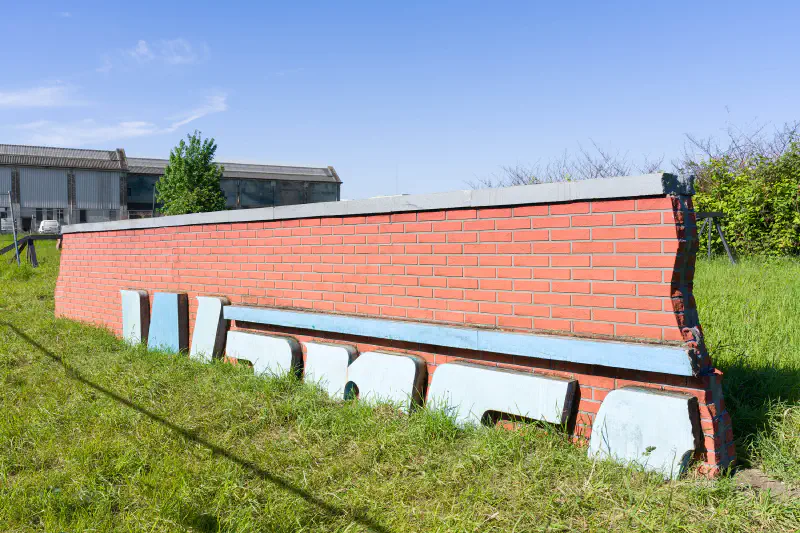
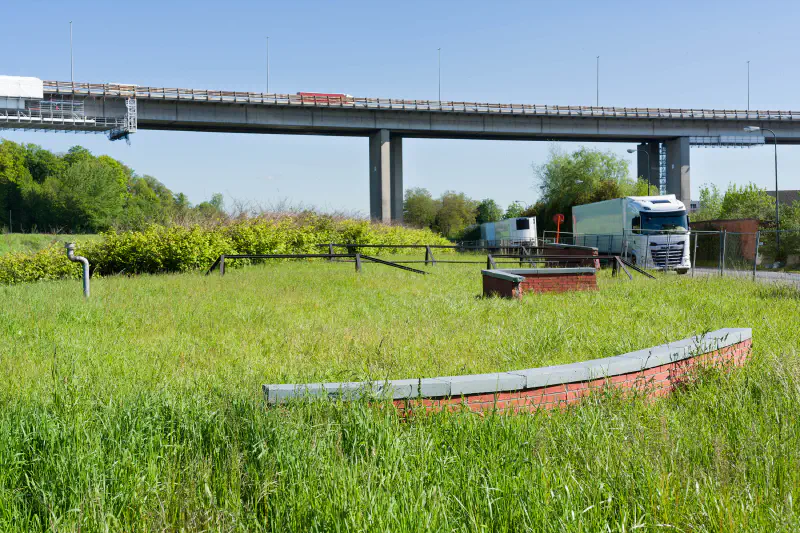
photo by Lola Pertsowksy
Elias Cafmeyer - Au Coeur Vaillant Rien d’Impossible, 2024
Harensesteenweg 353, Vilvoorde
The project of Elias Cafmeyer refers to the industrial history of Buda, which housed factories of many important industries. Imagining the area as an archaeological site and an attraction for tourists in the far future, the installation Au Coeur Vaillant Rien d’Impossible represents fictitious ruins of a factory that may have been located on the site. As Buda undergoes a process of transformation, Cafmeyer’s work alludes to the history that is embedded in the very soil upon which future residential and recreational infrastructure will be erected.
The architectural design of the structure is influenced by the former Wanson company building, where industrial steam boilers and kettles were produced, used to heat other factories in Buda as well. The building was demolished to accommodate the construction of the new Haren prison, which stirred controversy in Buda and its surroundings due to its architectural importance and the factory’s role in advancing and implementing modern workplace concepts. The organisational philosophy extended to offering workers amenities such as free dental care, access to a library, and even a meditation room, all located on the factory premises. The Wanson building exemplified modernist architecture, drawing inspiration from the design of the Belgian pavilion at the 1937 Paris World Fair. It featured sculptural elements intended to inspire its workforce. The title of Cafmeyer’s work, translated into English as “nothing is impossible to a valiant heart,” is a reference to a slogan that was inscribed on one of the walls at Wanson. In Cafmeyer’s work, the factory ruin serves not only as a fictional tourist attraction for architectural history but also as a symbol of the decline of the company’s pride and the deterioration of human relations within the cultural dynamics between employers and employees.
About
Mainly working with sculptures and video installations, Elias Cafmeyer creates site-specific installations often in public space or inspired by the use of public space in the context of the city. He sees the city landscape as a metaphor for social construction and focusses on traces of urban development and forms of signage orchestrating mobility. His interventions deal with strategies such as inversion, juxtaposition and contrast, creating a sense of alienation. Apart from his video installations, Cafmeyer often uses raw, industrial material such as metal, untreated wood and concrete. His site-specific installations result often in tragicomical illusions questioning the use and the representation of public space and its impact on the social construction in the urban landscape. He hereby investigates the friction between the personal gain of its user and its developer. His goal is to exhibit the differences of interest of policy makers and inhabitants by evoking a sense of surrealistic exaggeration of changes in city planning. These interventions react to urban phenomena such as gentrification, disneyfication and urbanization of the rural landscape. Elias Cafmeyer had the opportunity to exhibit in prominent Belgian museums such as S.M.A.K. (Ghent) and Extra City (Antwerp). He made temporary installations for the public space in collaboration with the cities of Antwerp and Ghent. He was invited for several solo shows as independent artist by art galleries such as Keteleer and mariondecannière (Antwerp) and had the opportunity to show work in The Netherlands, Germany and France. His solo show at spazioSERRA in November 2022 is his first exhibition in Italy.
Evita Vasiljeva

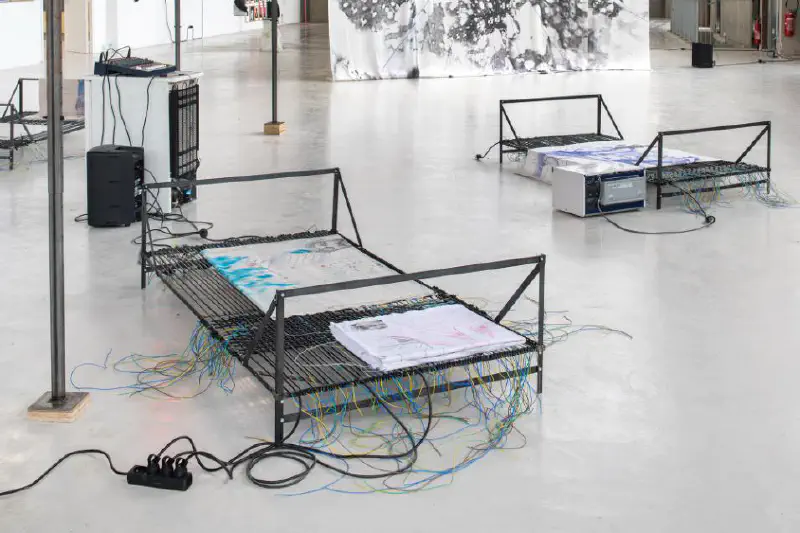
- 1 - If there is something heavy, there should be something light, 2023 Photo by Thomas Gunnar Bagge
- 2 - Bed-Room-Bed, 2021 Photo by Martin Argyroglo
Evita Vasiļjeva - A Short history of unresolved spaces caused by attempting a greater speed, 2024
Witloofplein (Dobbelenbergstraat - Verdunstraat), Brussels
The installation, titled A Short history of unresolved spaces caused by attempting a greater speed, comprises three large sculptures and several small block-like modules, playfully arranged around Witloofplein and engaging in a dialogue with the nearby industrial site and the train network that triumphs over the horizon with its grandiose pillars. Modernism promised more light, air, and space, with architecture grounded in new and innovative construction technologies such as reinforced concrete, steel, and glass. By employing faster construction methods and modular systems, structures ascended towards the sky, aiming to provide more affordable housing and improved speed and connectivity.
As buildings rose taller incorporating larger green areas around modular concrete architecture connected by highways for efficient movement, architects and urbanists overlooked that they have created pigeon holes in their system. High-speed bridge constructions created desolate spaces underneath, while highways transformed into noisy thoroughfares, prompting people to relocate away from them, which resulted in empty spaces between the lines of progress that is not clear what exactly to do with it. This space became an organic industrial zone of disorganisation (*In Buda, it represents an industrial zone. In France, it’s often viewed as dysfunctional social housing. In Latvia, they are unappealing sleeping districts, serving as reminders of the history of socialism).
The Witloofplein, perhaps more fittingly described as a noble roundabout than a conventional square, hosts one of the few bus stops that welcomes visitors to the Haren prison. Although the bus stop has no waiting shelter or seating element, the sculptures offer a place for contemplation, rest, and reflection. Furthermore, they serve as a physical interface between the freedom of movement and the seclusion of imprisonment, evoking this contrast through the use of coloured light and greenery within the square.
About
Evita Vasiljeva (b. Riga, 1985) mainly works with sculpture, installation, and sound. Having grown up in Latvia in the period of post-Soviet transition, the artist often draws on visual and sonic imagery of generic architecture and rough suburban landscapes. She creates sculptures and interactive installations by appropriating materials, usually used for construction, such as concrete, armature, metal profiles, lanterns, and various electrical appliances, and by combining them with household objects: beds and blankets, fridges, microwaves and soap, but also movement sensors which were commonly used in Latvia in the 90s to secure houses.By manipulating and repurposing a large variety of materials, Evita Vasiljeva invents her own aesthetic, as well as provokes relational dynamics between spaces, architecture, memory, and spectators’ bodies. While her works tackle the issues of anxiety and control, through ways of coexistence within the present moment, they always remain open for multiple interpretations.In 2022 Evita Vasiljeva was nominated for the 8th Purvītis Prize for outstanding achievement in visual art of Latvia and exhibited at the Latvian National Museum of Art in a duo exhibition with artist Kaspars Groševs. Recently, the artist has participated at the Lyon Biennial (2022, curated by Till Fellrath and Sam Bardaouil); Una Boccata d’Arte 2023, Italy (Fondazione Elpis, curated by Bruno Barsanti); Intermezzo, Moen, Denmark (Kunsthal 44Moen, curated by Rene Block); Baltic Triennial 14: The Endless Frontier, Contemporary Art Centre Vilnius (2021), (curated by Valentinas Klimašauskas and João Laia); Blue Lagoon House, Cēsis Contemporary Art Centre, duo exhibition with Kaspars Groševs, (2022, curated by Daiga Rudzāte and Žanete Skarule); Publiek Park, in collaboration with SMAK, Ghent (2021); the Salon de Normandy by the Community, Paris (2020, curated by the Community); Muzeum Sztuki, Lodz (2020, curated by Inga Lāce); Kim? Contemporary Art Centre, Riga (2019); Tallinn City Gallery, Tallinn (2018, curated by Kim?); Foundation Ricard, Paris (2018, curated by Barbara Sirieix, Maija Rudovska and Joachim Hamou); P/////AKT, Amsterdam (2017). Her works are included in the collection of the Latvian National Museum of Art and private collections.
Haseeb Ahmed
Haseeb Ahmed - Monument to the Monstrous Vortex Incident at Broekplein on April 6, 2024
Broekplein, Vilvoorde
“No man steps into the same river twice for he is not the same, nor is the river.” In this perpetual flow of time and water, how can we set one experience apart from another? Haseeb Ahmed’s sculpture and light installation creates hope that fantastic past moments might reoccur and be shared with others.
On the night of April 6, Haseeb Ahmed was installing a stroboscopic apparatus under the Broekplein. It is designed to “flash the flow” and create distinct images of the Senne River and Woluwe River just after they emerge from their manmade subterranean paths. He noticed extremely erratic eddies forming under the bridge. The vortices began to interlock, increasing their collective intensity. Eventually the depth of the unified vortex brought something to the surface. A bodily form emerged; defying physics. It looked to be made of the murky water itself but also something or someone more.
This artwork commemorates the incident. The stroboscopic apparatus remains under the Broekplein, recreating the conditions of Ahmed’s April 6 encounter. Members of the public can look into the river and see if the same figure emerges from the water. The best view is from a lookout point over the Woluwe and Senne River confluence, located under the new square. A sculpture located there commemorates the incident. Ahmed asked 3D artists to recreate the scene based on his description. He carved these scenes and they are featured in the sculpture as reference for observers on the lookout for the monstrous vortex.
The sculpture at the lookout strobes at the same frequency as the lights under the bridge to synchronise the two places. Our experience is based on what we can sense, especially see. The strobe flashes every half second making our experience of time slower. This might yield more time to live and to see the extraordinary monstrous vortex witnessed by Ahmed on April 6.
About
Haseeb Ahmed (b. 1985) is an American artist who lives and works in Brussels, Belgium. He produces objects, installations, and films. His work is often collaborative and draws from the hard sciences, blending art and aeronautics, myth and technology, to create new narratives. Over the last 10 years Ahmed has structured his research-based artistic practice around fluid dynamics of wind and water. His focus is on what we can learn about our changing climates through the movements of the wind and the waters by what they carry, both physically and in terms of cultural associations throughout history.His work was the subject of a solo exhibition at the Museum of Contemporary Art (Antwerp, BE) and has been exhibited internationally at the Göteborg Biennial (Göteborg, SE), Museum Bärengasse, (Zurich, CH), The Museum of Contemporary Art (Chicago, USA), De Appel (Amsterdam, NL), and the Frestas Triennial (Frestas, BR), amongst others
Ignace Wouters
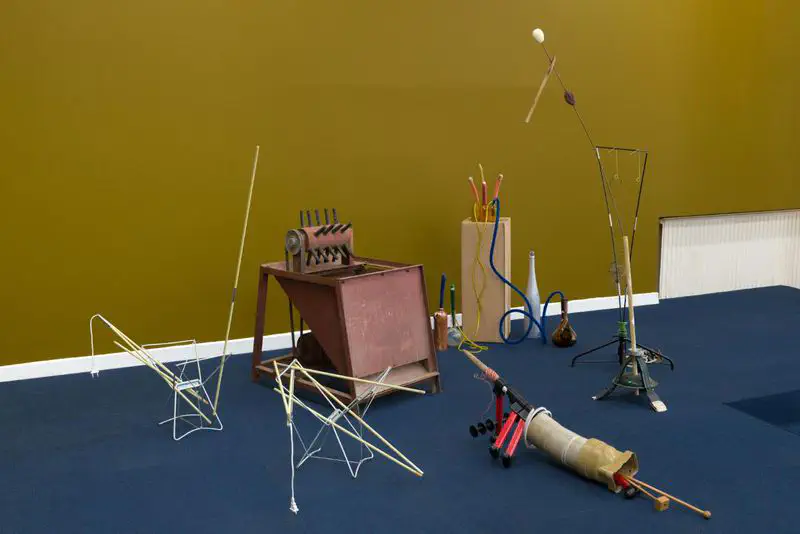
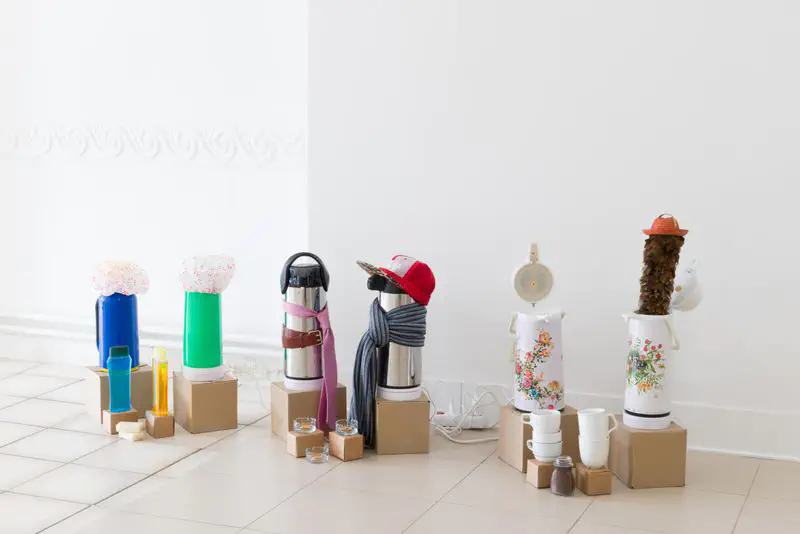
1 - Installation View, The Conspiracy of Influencing Machines, 2023 (foto: Lola Pertsowsky)
2 - Installation View, Pump Pots, 2023 (foto: Lola Pertsowsky)
Ignace Wouters - Droomland Buda, 2024
Emmanuellaan - Nieuwbrugstraat, Machelen
Bushalte Diegemstraat, Vilvoorde
The Corner, Machelen
Droomland Buda consists of several artistic propositions that will unfold throughout the duration of Border Buda. The central motif of the project is an ambiguous depiction of a worker (or a knight, possibly a witch) by Italian artist Mario Mariotti which appeared in 1964 in the Marxist magazine Classe Operaia. This mysterious figure, both combative and haunting, pays homage to the social struggle of the past and present workers of Buda. It looms over the area from the facade of the former Renault factory and recurs in each of the artists’ interventions.The worker-figure’s placement and materiality, reminiscent of the signboards adorning the walls of Buda’s factories and businesses, is representative of the overall tactic of Droomland Buda. By mimicking the aesthetic strategies that are already present within the confines of the industrial zone, Ignace Wouters playfully subverts existing visual regimes. Making manoeuvres within the enemy’s field of vision, his interventions critically tackle concepts like memory, forgetfulness, and history, inviting the visitor to reflect on the capitalist forces that both shaped and ruined the area and consider what was lost and what was gained.
The second intervention can be found at The Corner, a café frequented by those who work or pass by Buda, seeking food, drinks and respite from labour. Throughout Border Buda, meals at The Corner will be served on a series of disposable placemats designed by Ignace Wouters, incorporating references to Buda’s industrial past and future. The third intervention consists of a reissue of a selection of articles by local historian Ludo Jappens. These texts, which were originally published in the regional history magazine Machala, reflect on the historical importance of Buda through a series of well researched micro-histories. For the occasion Wouters has reimagined the shape of Jappens’ writings in the form of a limited edition goodie bag. It will be presented on the opening weekend and distributed near the end of Border Buda via a lottery open to all visitors. Finally, a series of posters tampering with the routine circulation of visual information will appear sporadically on the billboards on Schaarbeeklei, close to the bus stop Diegemstraat.
About
Ignace Wouters was born in Genk in 1992 and lives in Brussels. Before deciding to become an artist he studied art history. When we asked him for an introductory text to publish on our website, he sent us the following: “When playing the role of artist I like to interrogate situations and conventions. In my work certain themes keep reappearing: visual identity (how is our world shaped and produced?), history (how does our perception of the past contribute to our view of the present?), humor (which joke allows us to see reality better?) and criticism (which assumptions are worth challenging?).”
Ilke Gers
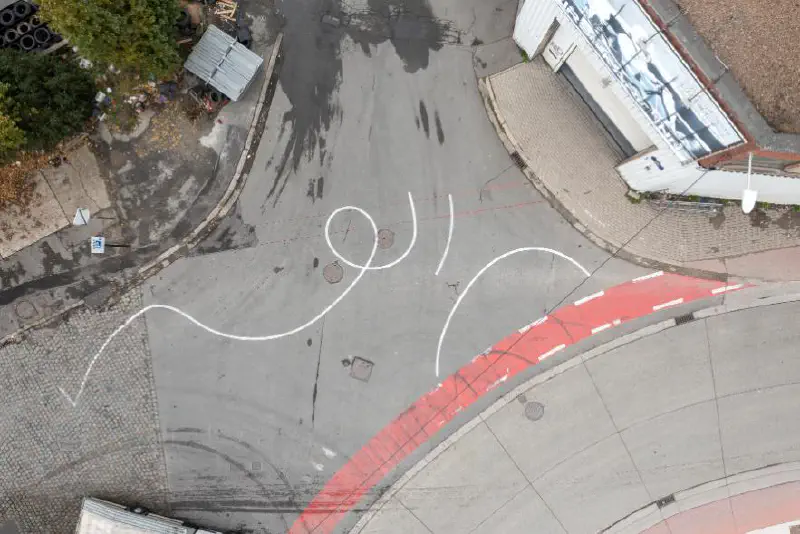

Ilke Gers – Landmarks, 2023
Gillekensstraat – Harensesteenweg, Vilvoorde
Schaarbeeklei 700, Vilvoorde
Station Buda
Emmanuellaan – Budasteenweg, Machelen
Karting, Budasteenweg 2, Machelen
Hamweg, Brussel
Witloofstraat – Verdunstraat, Brussel
Landmarks is the first artwork in public space for Border Buda. consists of nine ground paintings at various locations in Buda, crossing the borders of Machelen, Vilvoorde and Brussels. Landmarks originated from boundary markers dividing lands and kingdoms, which over time became more generally used as conspicuous markers in the landscape for finding one’s way.
The nine ground markings at specific points across Buda can be used as points of reference for orientation and movement. Each marking or gesture relates and responds to its location, together fitting into a sequence like a sentence. Accessible by foot, the locations of the markings create a walking route that can be followed as a starting point for a new way to navigate, embody, and draw together different locations spanning the three municipalities.
Nearly half a year after the inauguration of Landmarks in October 2023, the ground markings now vividly illustrate the activities unfolding in the area. Frequently traversed by vehicles of varying sizes, some drawings are fading away gradually, like blurred and blurring borderlines.
About
Ilke Gers (1981) is a visual artist from Aotearoa New Zealand, based in Rotterdam. She makes installations and works with text, drawing, print and publishing to explore the relationship between the body, movement and language. Her work intervenes in standardised forms of communication and circulation, through open-ended processes that are contingent on spatial conditions, physical interaction and time. Her work has been presented at the Hayward Gallery at Southbank Centre (London), NDSM Werf (Amsterdam), LLS Paleis (Antwerp), the Biënnale Van België (Ghent), Kunsthal Rotterdam, 019 (Ghent), De Appel (Amsterdam), De Fabriek (Eindhoven), D21 – Kunstraum (Leipzig), and Beursschouwburg (Brussels). She holds a Master from the Werkplaats Typografie, and was artist in residence at the Jan van Eyck Academie (2014-2015).
JEAN KATAMBAYI MUKENDI

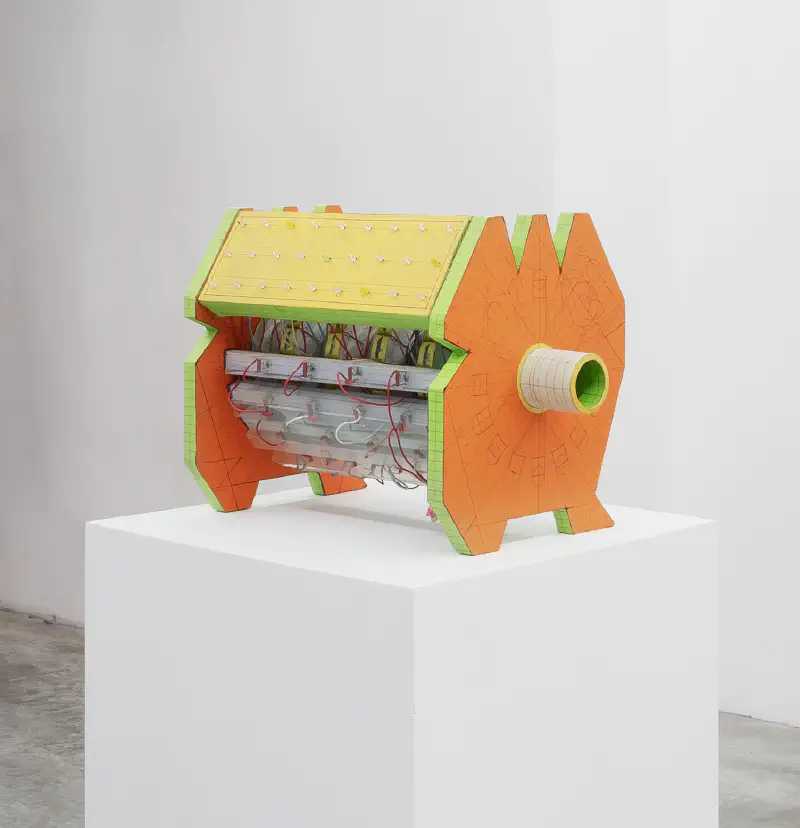
Afrolampe, 2022, Ink on paper, 100 x 70 cm. Courtesy Wouters gallery and the artist.
Lester, 2011, Cardboard, electrical wires, led lamps, 30 x 50 x 30 cm. Photo by Luk Vander Plaetse.
Jean Katambayi Mukendi - Dialyse, 2025
Work on view during Border Buda Expo:
Afrolampes, 2021-2023
Budasesteenweg 96, Brussel
Jean Katambayi Mukendi’s work Dialyse will be inaugurated on the occasion of the 70th anniversary of the Buda Bridge in 2025, situated adjacent to this historic landmark. The work bears reference to the process of dialysis, a treatment for kidney failure in which waste products are excreted from the blood. This therapeutic procedure holds particular significance in urban settings like Jean Katambayi Mukendi’s hometown of Lubumbashi, where the population is increasingly exposed to metallurgical or chemical toxicity on a daily basis. Industrial pollution leads to physical pollution, exposing the intricately linked triangular relationship between energy, economy and ecology at macro and micro levels.
Near the Buda Bridge, the Willebroek canal was once flanked by numerous heavily polluting industries, including the Cokeries de Marly and Eternit. This area was enveloped in dark, noxious plumes of smoke until just a few decades ago. These industrial activities led to significant soil pollution, with various contaminants seeping into the groundwater and waterways. Efforts have since been made to remediate the soil on large plots of land, and since 2007, the Aquiris wastewater treatment plant has been tasked with treating Brussels’ wastewater to help restore the Senne River to a healthy state. The canal and the Senne, along with the adjacent roads dominated by cargo traffic, serve as the arteries of the capital region. In Dialyse, Jean Katambayi Mukendi makes substantive connections between Buda’s industrial past and the violent mining industry in Lubumbashi, where the mining of raw materials, such as cobalt, has pernicious social and ecological consequences.
This work will be created with the support of Julien De Bock.
From April 26 to May 26, visitors to Border Buda will be able to view Jean Katambayi Mukendi’s series of drawings Afrolampes (2022), which will be reproduced as banners near the location where the future artwork Dialyse will be inaugurated. The drawings establish an intriguing connection to the other artworks featured in Border Buda, many of which explore the (im)materiality of light as an indicator of speed, distance and time. The placement of Afrolampes in front of Buda Bxl, which occupies the historical site of the Eternit factory, serves as a prelude to the themes explored in Dialyse.
About
Jean Katambayi Mukendi was born in 1974 in the Democratic Republic of the Congo. He lives and works in Lubumbashi, DRC. Trained as an electrician, his entire artistic practice is imbued with his fascination for mathematics, engineering, geometry, and technology. Profoundly marked by his upbringing in the workers’ camp of his mining hometown and by its mechanisation, Katambayi creates fragile and complex installations and drawings inspired by sophisticated electrical circuits and technological studies. His works are part of a search for solutions to social problems in current Congolese society, as well as to the country’s depletion of its enormous energetic resources. Often made of recycled and impermanent material, such as cardboard and recycled electronic material, the artist’s poetic pieces attempt to redress the imbalance of the world’s hemispheres. (www.waldburgerwouters.com)
Katja Mater

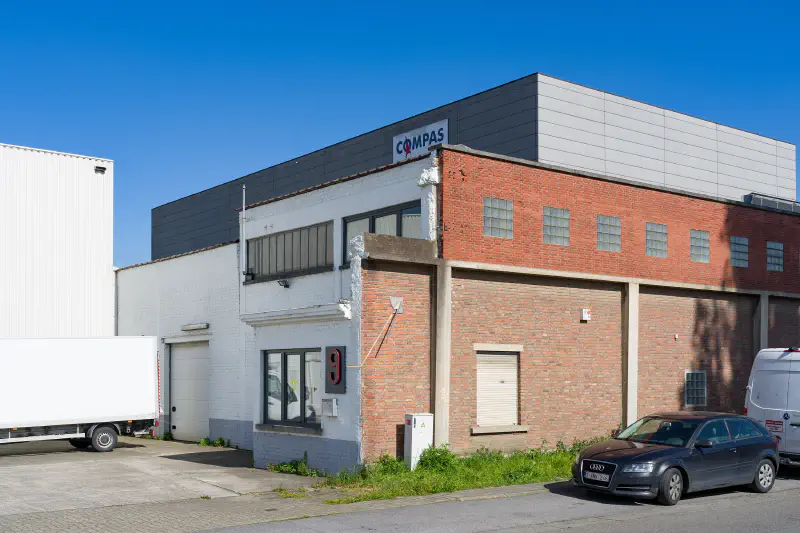
photo by Lola Pertsowksy
Katja Mater - HIC . EST . TUUM . HORA, 2024
Diegemstraat 1, Vilvoorde
Karting, Budasteenweg 2, Machelen
Emmanuellaan 9, Machelen
Vaartdijk 36, Brussel
Fobrux, Vilvoorde
Time flies. Time binds. Time heals.
Time is killed. Time is money. Time will tell.
Make Time. Waste Time. Due Time.
One perspective on Time defines it as a measure of change. In this view, clocks serve to track changes, visually representing the progression of seconds, days, or even seasons and years. The use of the sun for timekeeping dates back to prehistory. Sundials typically consist of a flat surface, known as the dial, and a gnomon, an object that casts a shadow onto the dial. As the sun moves across the sky, the shadow aligns with different markings on the dial, enabling interpretation of its position.
Katja Mater’s work consists of five single-hour markings placed throughout Buda, transforming the area into a (part of a) large-scale sundial. Each part uses a number that was already present, giving it the additional task of telling (summer) time. At 9:00 in the morning, the shadow of the street sign indicating 9 km to Brussels, located at the intersection of Schaarbeeklei and Diegemstraat, meets a marking on the wall. Simultaneously, a shadow is cast on the red house number at Emmanuellaan 9. At 13:00, we can observe a shadow on the large number 1 on the facade of Diegemstraat 1. At 14:00, a shadow falls on the numeral 2 to the right of the entrance of the First Kart-Inn, and at 16:00, another one appears on a graffiti-marked IIII on a wall next to the canal at Vaartdijk. The title or motto of Mater’s sundial, HIC . EST . TUUM . HORA (HERE . IS . YOUR . HOUR) serves as both a reminder and an offering to a passerby.
This work was created with the support of Hendrik Hollander.
About
Katja Mater (NL, 1979) is a visual artist, editor, organizer and educator with a practice that focuses on the optic media as non-transparent. By creating hybrids between photography, film, drawing, performance and installation Mater documents something that is often positioned beyond our ability to see. Interested in revealing a different or alternative (experience of) reality through capturing the areas where optical media hardly behave like the human eye. While mediating between time, space, perception and our understanding of them, Mater records events that simultaneously can and cannot be – holding midway between information and interpretation.
MARINE KAISER
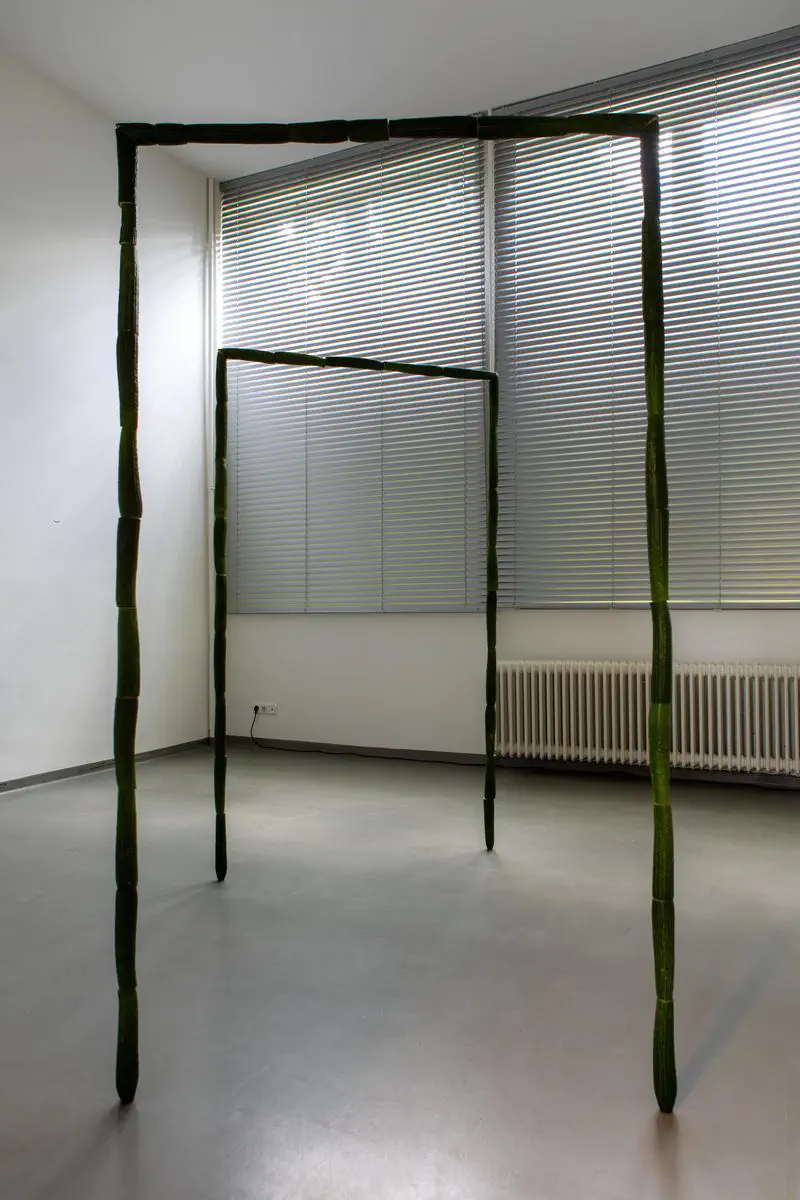

- 1 – The assistant Jan van Eyck Academie
- 2 – The only thing that can affect magnetic inversion is bad news. Photo by Nikos Staikoglou
Marine Kaiser - Fleurs de Buda, 2024
Vaartdijk, Brussels
As sung by Della Bosiers in her ode Fleur de Buda (1971), vegetation in the area is strikingly sparse. In the few places where it does thrive, we mainly encounter species that are classified as invasive. Invasive alien species originate in ecosystems far removed from the one in which they are established. Whether due to botanical hubris or international trade, the displacement of species sometimes leads to uncontrolled behaviours. While these species may be perfectly well-behaved in their native ecosystems, when transplanted to distant locations, they either disrupt the balance or establish themselves in areas where the ecosystem is already out of balance. One such example flourishing in Buda is the Japanese Knotweed, which was brought from Japan in 1829 by Philipp Franz von Siebold. As Japan was still tightly isolated during this time, the knotweed most likely began its journey from the artificial Japanese island of Dejima, which served as a trading post for the Dutch. Once regarded as an outstanding species, earning an award in 1847 from the Society of Agriculture and Horticulture in Utrecht, this rhizomatous plant is now viewed as an odious invader who must be disposed of. Japanese Knotweed arrived in Europeconcurrently with the onset of industrialization, coinciding with the very factor responsible for soil pollution. This pollution sets the conditions in which knotweed is one of the few species that happens to thrive in the area.
In Fleurs de Buda, Marine Kaiser sets a dialogue between the local knotweed and peony, two rather differently valued species of plants. Peonies, which are now among the most beloved flowering plant species in Belgium, are held in similar esteem as the knotweed once was. While originating in China, their name in European tongues references Paieon, the Greek god of healing.
In Marine Kaiser’s work, cut peonies are placed in a spill containment tank – a device typically used to prevent hazardous or polluting substances from spreading. While containing the histories and narratives that the plant species embody, Fleurs de Buda offers an entry point for questioning the apparent transitions taking place in Buda.
About
The documented narratives of Swiss-French artist Marine Kaiser (1992) investigate the networks, tactics and arrangements generated through the applications of control. Borders in displacement, invasive species, sculpture in changing states, a closed eye allowing the gaze to pass, passwords ; Marine Kaiser’s interventions compose contradictions and complexities by standing at the thresholds of temporary communities. Graduated from HEAD Geneva and Erg Brussels, her work has lately been exhibited at Espace Contact (Neuchâtel), reclame (nomadic), Pavillon de l’Arsenal (Paris), AGB (Berlin), Manifesta 12 (Palermo), Le 18 (Marrakesh), Les Brasseurs (Liege), Palais de l’Athénée (Geneva), KANAL - Centre Pompidou (Brussels). In 2021/2022, she was artist-in-residence at Jan van Eyck Academie (Maastricht).
Nel Maertens
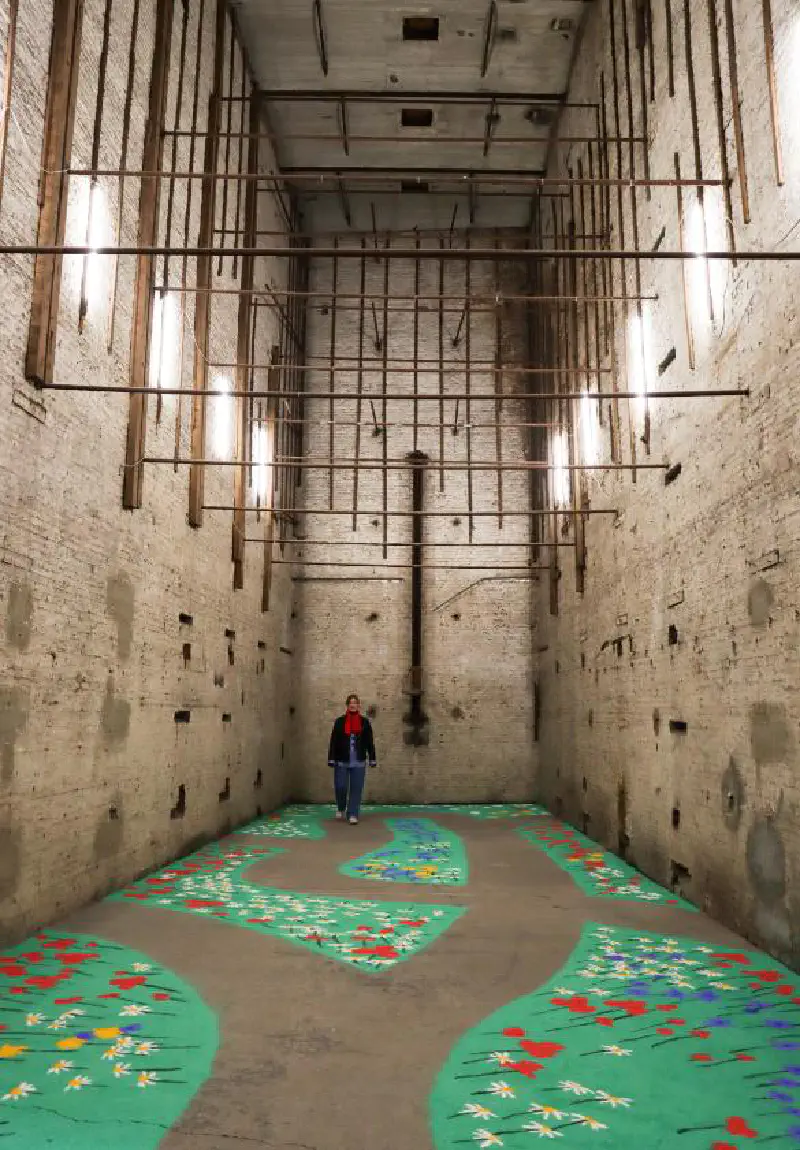
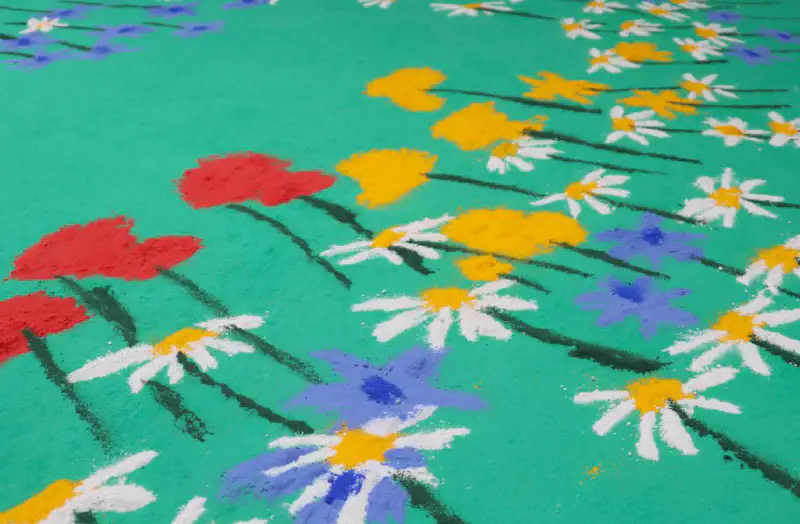
Nel Maertens - Zaaien en Oogsten, 2024
firma, Schaarbeeklei 636, Vilvoorde
Before the development of roads and industrial infrastructure, extensive floodplains stretched on both sides of the Senne River. These fertile lands were teeming with wild flora and fauna, while agriculture thrived on the higher plateau. Drawing attention to the fleeting biodiversity, Nel Maertens creates an installation called Zaaien en Oogsten (in English - Sowing and Reaping). The installation portrays a vibrant field, featuring flowers and greens, crafted using brightly coloured pigment diluted in wheat flour—a material sourced directly from the fields.
For the third iteration of Zaaien en Oogsten, Nel Maertens finds inspiration in the surroundings of firma, nestled in the heart of the Buda district between the canal, the Senne and the viaduct. The wildflowers and plants flourishing in this industrial part of Vilvoorde — alongside train tracks, bustling roads, and the canal — serve as the foundation for a vibrant, large-scale flower carpet. The spacious, unrefined art space of firma and cantine, housed within an old factory building, provides a balanced counterweight to the natural, brightly coloured installation.
About
Nel Maertens (1996°, lives and works in Antwerp) explores colour, material, writing, and energy in her work. Nel graduated with a master’s degree in fashion from the Royal Academy of Fine Arts Antwerp in 2019. Besides projects in the performing arts (costume design, performance), Maertens focuses on an autonomous visual art practice. She is an omnivalent artist who enjoys cross-sector collaborations and is a member of the artist collective FAAR.
Nel participated in group and solo exhibitions at home and abroad, in 2021 Charlotte Crevits curated a first solo exhibition of her work at CC Strombeek. This was followed by several residencies and collaborations with KMSKA, Europalia Georgia, Het Rubenshuis, Platform K and choreographer Femke Gyselinck, We Are The Next Generation, Art On Paper, Wouters & Hendrix, Coppejans Gallery, Baroque Influencers, Dieric Bouts Festival, Flanders DC Antwerp,… among others.
The three “classic” genres within art history; the portrait, the landscape and the still life, return again and again. Themes such as feminism and universal emotion she wants to revisit and actualise. Nature conservation and climate change are also important drives in her work.
Nico Neefs and Colas Fiszman
Nico Neefs & Colas Fiszman - Collective Synesthesia, 2024
Buda Bxl, Budasesteenweg 96, Brussels
Located at the exact border of two cities and two regions, the location Buda Bxl stands as a vibrant hub where visual, sonic, and choreographic arts converge. Formerly an industrial factory, it has transformed into a thriving community space, hosting concerts, raves, performances, residencies and exhibitions. Buda Bxl is now a cornerstone of Belgium’s nightlife scene. In this setting, visual artists Colas Fiszman (BE, 1979) and Nico Neefs (BE, 1987), resident of Buda Bxl, present Collective Synesthesia, a collaborative monumental light installation. Comprising over 16,000 light points, the piece transforms Buda Bxl’s facade into a sprawling canvas of light and colour. Inspired by the idea of creating an organic and shared experience, the installation becomes a dynamic platform for experimentation, fostering collective exploration of light and digital technologies. By blurring the border between localities, it fosters connections and collaboration. In 2024, the artists will launch a series of workshops, inviting international artists and experts to facilitate exchanges among artists from diverse backgrounds and to introduce participants to cutting-edge digital art technologies.
PIETER CHANTERIE

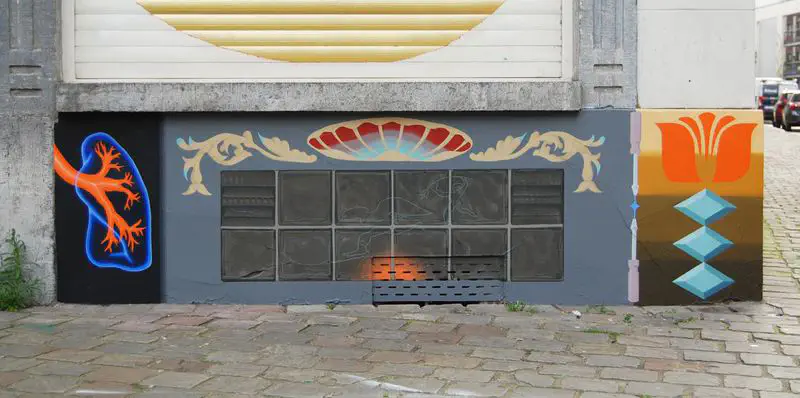
1 – Open Your Chest to the Sky – I Miss You, my Diva (based on Crivelli’s Annunciation), 28,5 cm x 28 cm, Various painttypes on wood, 2023
2 – The Barrel Organ (right panel), 63 cm x 2 m 40, Facade paint and acrylic paint on outside wall, 2023
Pieter Chanterie - The Showroom, 2024
Buda station
Dobbelenbergstraat 25, Brussels
Dobbelenbergstraat 87, Brussels
Three murals mark a path from the Buda station to the former building of the U.P.L. – a renowned wallpaper manufacturer that once employed numerous famous artists as part-time designers. Pieter Chanterie departs from the historical narrative and the archives of the U.P.L., intertwining it with fiction, to narrate the story of a bold female designer who journeyed along the same route to the factory every day on her way to work.
The title of Chanterie’s mural works refers to staged commercial spaces that were used to demonstrate the varieties of U.P.L.’s wallpapers in the past. Showrooms served as both samples and tools for design inspiration, perhaps even slightly resembling human-size dollhouses aimed to embody the domestic fantasies of their clients, as well as the ideas of beauty and décor. Chanterie explores feminine and queer motifs associated with the factory’s history, while also delving into the technical aspects of wallpaper manufacturing.
Implementing original U.P.L. designs in his murals, the artist revisits the techniques employed in the early days of manufacturing. During this period, patterns were hand-printed on fabric using engraved blocks and rolls, with intricate details delicately filled in by the skilled hands of the workers. The wallpaper patterns in The Showroom have been handcrafted, refusing the use of more automated techniques that accelerated the wallpaper manufacturing process. Chanterie, who adeptly transitions from miniature to mural in his artistic practice, drawing upon art-historical tradition. He employs the trompe l’oeil technique to further accentuate the blending of reality and fiction in his visual storytelling. Historical anecdotes are intricately woven into the very details of the murals, such as splatters of paint on the characters’ trousers – once tell-tale signs of the colours the workers had used that day in the factory before heading home.
About
Pieter Chanterie is a visual artist, born in 1996, in Leuven. He lives and works in Brussels.His work varies from small paintings on wood to murals, drawings, (wall) sculptures and books. There’s a large focus on the object in itself and its materiality, but also on making the 3D- or 2D-object a window to elsewhere. His visual language is a medley of contemporary and historical imagery, from infographics to Medieval miniatures. This sweet ‘n sour cocktail decorates the stage for spiritual, personal and fictional novellas.
ZINAÏDA TCHELIDZE

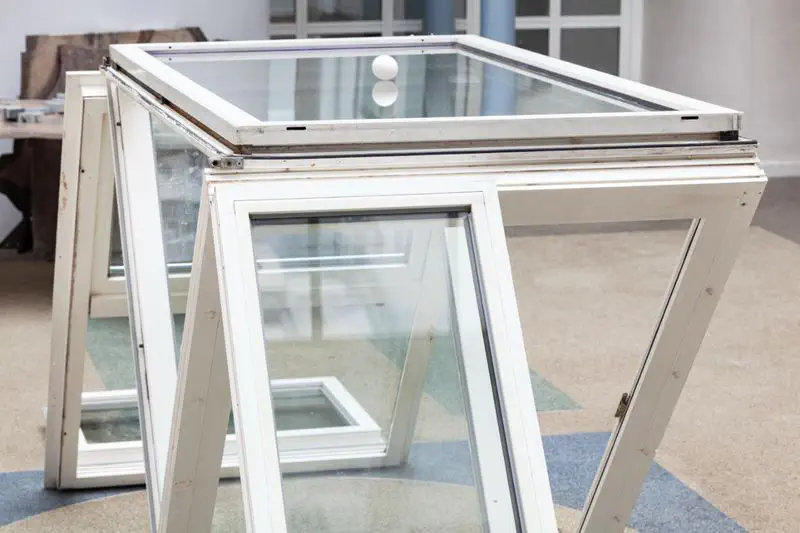
- 1 - Installation View, Parking Me, credit: Fabrice Schneider, 2022
- 2 - Installation View, Cuttings, credit: Natalie Malisse, 2022
Zinaïda Tchelidze - Tête-à-tête, 2024
Vaartdijk, border Vilvoorde - Brussels
In Buda, with its industrial character, it would be rather unusual to stumble upon a planned seating area. Perhaps it is the lack of captivating views or simply the neighborhood’s tendency not to lend itself to rest and leisure, which benches often offer. Crossed by the border between Brussels and Flanders, Buda’s locus not only delineates an administrative divide but also embodies the social and linguistic complexities inherent in collaboration across such divides.
Zinaïda Tchelidze’s installation Tête-à-tête emerges from a liminal zone. Composed of the structures found in the Brussels city depot in Buda, remnants of Brussels’ urban planning and infrastructure, this reconfigured object refers to the emotional and historical connotations that persist in transitional spaces. It contains both the potential for an intimate encounter and the discomfort thereof.
Zinaïda Tchelidze plays with an outsider’s gaze, often inclined to aestheticize or romanticize elements associated with decay. Subtly touching upon the revitalization processes and their actual impact on the local social structures, Tchelidze’s work is an anti-form of what it originated from, or perhaps an anti-monument to desires, ambitions, and political projections placed on the bordering zones.
About
Zinaïda Tchelidze (b.1982, Georgia) is an artist and educator, working mainly with sculpture and installation. She obtained an MA in printmaking and art in public space from the Royal Academy of Fine Art of Brussels. Tchelidze is interested in performative aspects of exchange and sharing. She engages with recurring gestures, intertwines them throughout installations to explore spatial constraints, notions of collectiveness and isolation. As part of her collaborative practice she works with craftspeople, scientists, and artists to test the boundaries between creativity and (not)knowing. Inspired by the traditional Georgian feast (supra), she has been organising the “Rubeli” performative table questioning the phenomenon of hospitality and exchange, and their different forms in relation to time and social conditioning.Tchelidze lives and works in Brussels. She has exhibited at various venues such as Art Antwerp fair for the representation of the FW-B (2022); SB34-Clovis, Brussels (2022); Het Paviljoen, Ghent (2021); Morpho, Antwerp Art Weekend (2021); DuflonRacz, Brussels (2019, 2020); Vanderborght Building, Brussels (2019); CENTRALE for contemporary art, Brussels (2019); World Trade Center, Brussels (2018), among others.
© 2024 BORDER BUDA – ALL Rights reserved